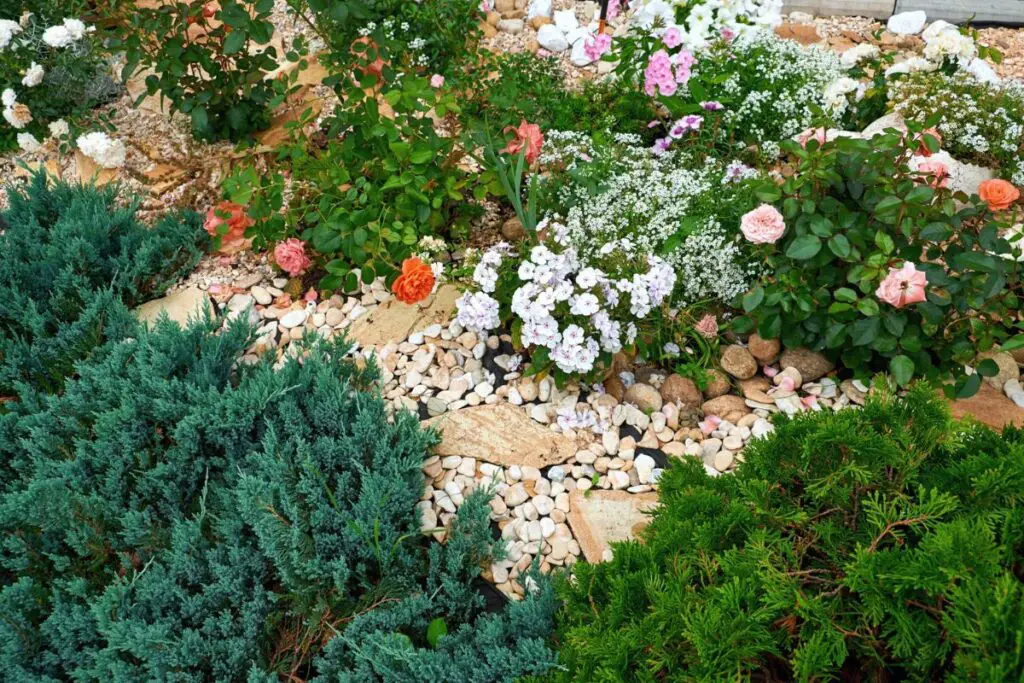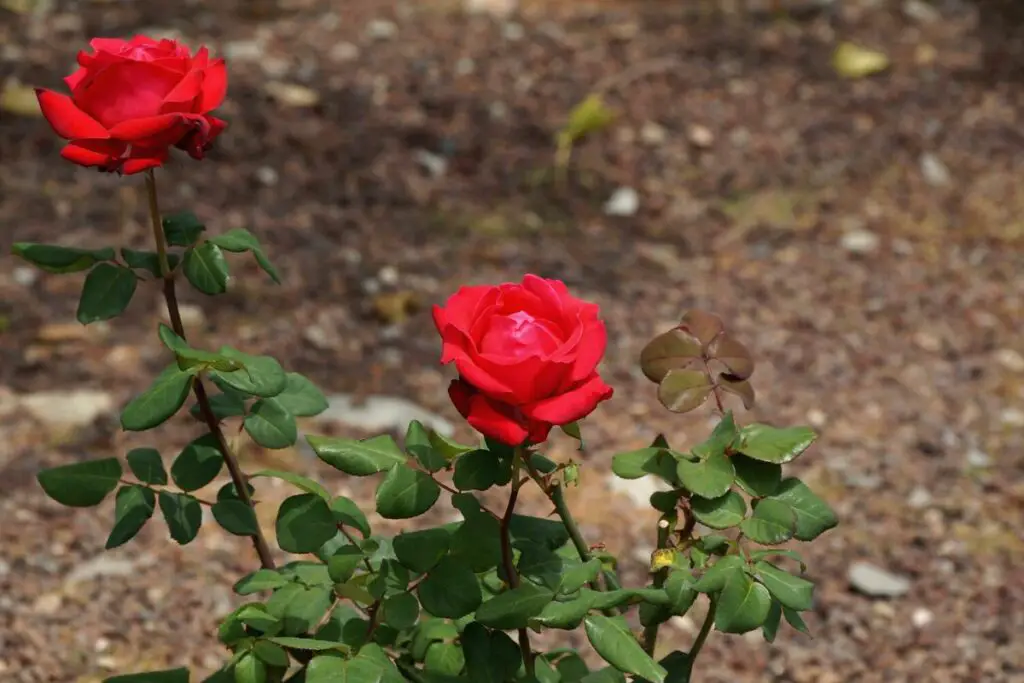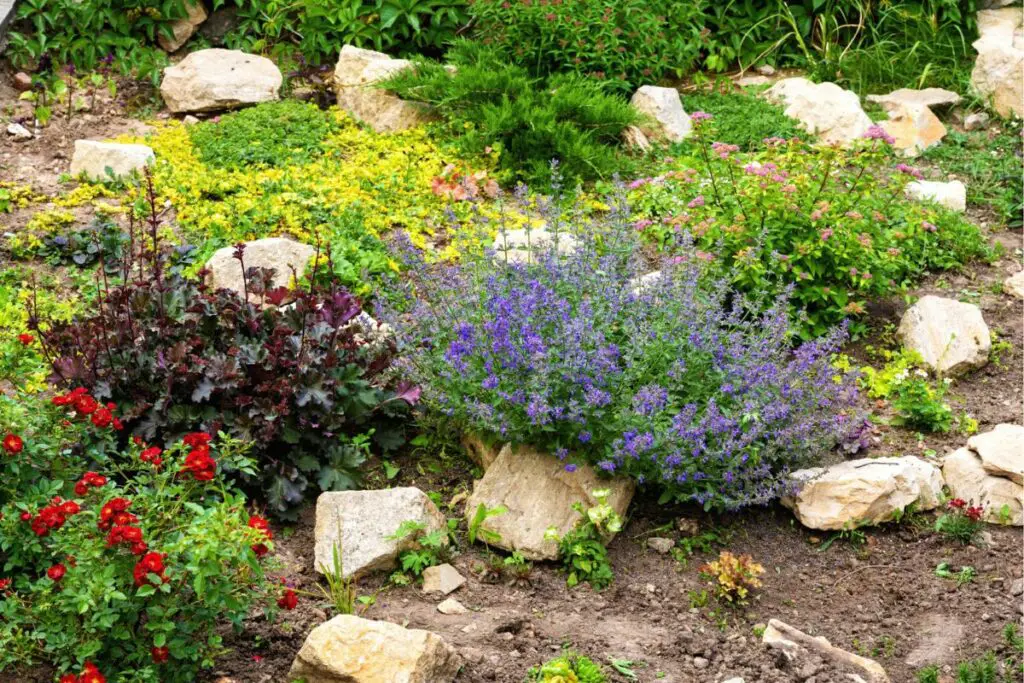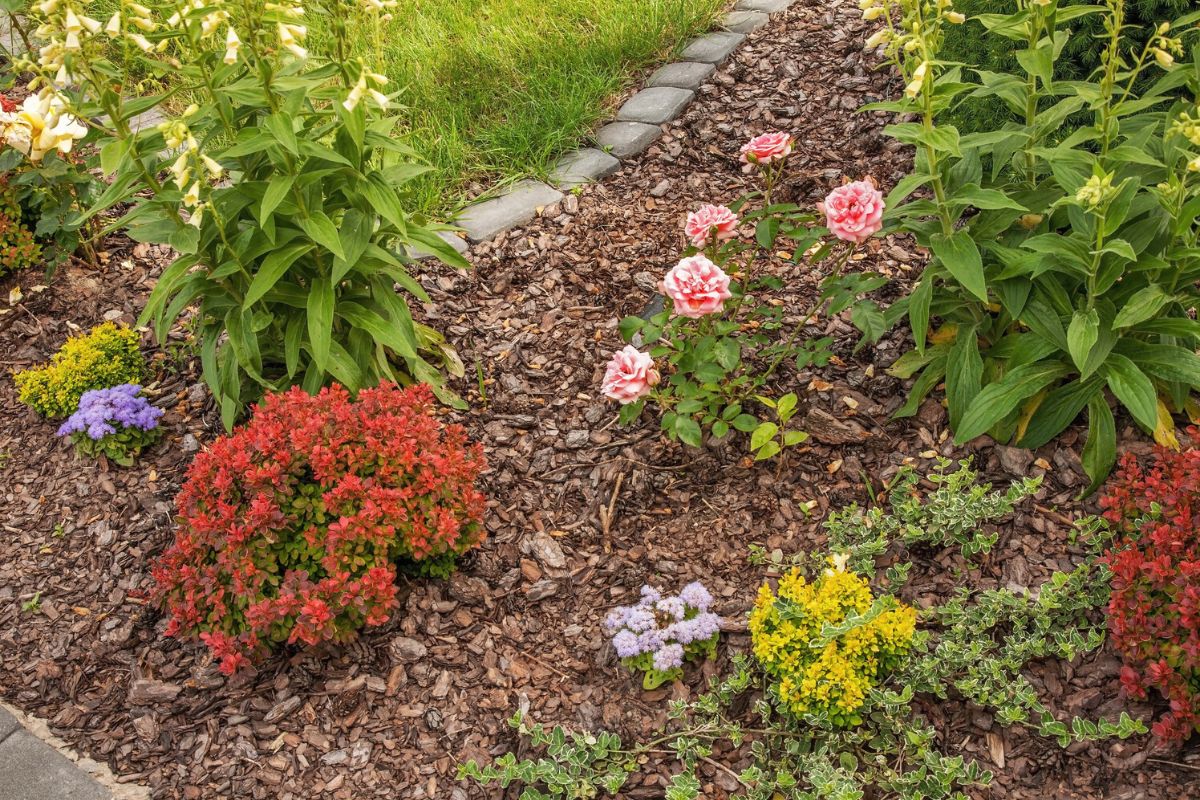Roses are an ideal flowering plant for any garden with their long-lasting, bright blooms and classic beauty. However, if you want to put together a rock garden with a rose bush, there are some special considerations that you should take into account.
You can plant roses in a rock garden. Roses appreciate ample soil drainage, and rocks can help provide that. However, you may need to closely monitor the soil’s pH, fertility, and moisture to ensure that your roses stay healthy.
So, let’s talk more about how to incorporate roses into your rock garden. I’ll tell you the particulars and help you set up your rose’s spot to ensure the best chances of flourishing.

How Rock Gardens Affect Rose Growth
Roses grow well in rock gardens, but rock gardens need some improvements before they can sustain roses. You must frequently monitor the soil quality, stone placement, and soil moisture to ensure that the conditions are ideal for your species of roses.
Roses aren’t the most straightforward choice for rock gardens. They generally need more room and better soil quality to survive in a stone bed than most common rock garden plants. However, roses can thrive in rock gardens if you treat them right and take care to tailor your garden to your rose species’ needs.
Optimizing Your Rose Garden
Here’s a list of the optimal conditions for most species and cultivars of roses:
- Partial to full sun (6-12 hours of sunlight)
- Fertile soil with a balanced NPK ratio
- Ample drainage
- Acidic soil with a pH between 6 and 6.5.
So, let’s compare these conditions, keeping in mind a rock garden’s unique requirements. Let’s discuss how you can improve the rock garden to grow healthy roses that last for many years.
1. Check That You Have Enough Space for Your Roses
Did you know that there are over 150 species of roses globally and even more cultivars and hybrids? Each of these roses has particular requirements that vary. One of the most noticeable differences between these species is their size.
The smallest rose, the micro-mini, only reaches 1 to 2 feet (0.3 to 0.6 m) tall. The largest rose bush in the world is a White Lady Banks, over 8,000 square feet (743 square meters) in size.
So, before settling on a rose, you’ll need to consider how large it will get and how much real estate you have in your rock garden. If the garden is small, go with a mini rose or a dwarf variety. If you have plenty of space, pick a bush that will get a bit larger.
2. Place Roses in an Area With Full Sunlight
Although you can get away with keeping your roses in partial sun, it’s always best to ensure they get 6 to 12 hours of sunlight daily. While that sounds straightforward enough, you’ll also need to factor in sun requirements when building your garden and selecting your other plants.
So, since roses need full sun, it’s best to put them in a location with southern exposure. Then, select other plants that appreciate full sunlight.
3. Fertilize Your Soil
Roses grow best when you offer fertilizers with a 1:1:1 nitrogen, phosphorous, and potassium ratio. Roses need these fertilizers when they start to grow again in spring, and they can also benefit from a few extra nutrients mid-summer when the flowers begin to come in for the second time.
You should also regularly enrich your soil with compost or place slightly acidic mulch around your roses to ensure that your soil retains enough moisture for your plants.
4. Ensure That Your Substrate Has Ample Drainage
While rock gardens usually have the best drainage of all garden types, it’s still worth mentioning that roses love moist soil with adequate drainage. For that reason, roses often grow best on slight slopes in rockier soils with loam.
When you create your rock garden for a rose plant, you’ll want to fill the garden bed with soil that includes ⅓ sand, ⅓ clay, and ⅓ humus or compost. This soil mixture is already a common choice for rock gardens, which is why roses are excellent for these planting areas.

5. Amend Your Soil With pH-Adjusting Components
Most rose species grow best in soils with a lower pH of 6 to 6.5. When selecting your soil and your roses’ companion plants, you’ll need to keep this pH in mind.
To ensure that your soil stays balanced, I recommend monitoring the soil quality closely as your roses grow. You can use a soil tester/meter. These monitors will last much longer than chemical soil test kits.
If you find that your soil’s pH is out of whack, you’ll need to mix something into the planting medium to improve it. Be sure to adjust the soil pH for your roses before planting them, then measure the soil quality about every six months to keep up with it and your rock garden plants.
The experts at Iowa State recommend using amendments like acidic mulch, sulfur, aluminum sulfate, and peat moss to your planting medium. You can incorporate hydrated lime into your garden soil if you need to raise the pH.
The Downside of Putting Rocks Around Roses
You should not put rocks around roses. While placing large rocks a few inches from the base of the plant will not harm your roses, placing stones too close could amplify the sun’s heat, burning and drying your rose bush.
So, roses do best in a rock garden with plenty of soil space and little to no stones surrounding the base of the plant. Otherwise, you risk giving your plant a sunburn that might prove fatal to the flowers.
If you still want to incorporate gravel or river stones on the topsoil, you can create a barrier around your roses with pavers or larger stones. I recommend placing this barrier at least 4 inches (10.16 cm) from the base of your roses to ensure that the sun’s reflection does not scorch the leaves.
Best Companion Plants for Roses in a Rock Garden
Roses grow best when they have companion plants. Lower-growing flowers and crawling plants can help protect the roses from pests, overexposure to sunlight, and diseases. However, finding plants compatible with roses that grow well in rock gardens can be tricky.
So, let’s look at some of the best plants to keep your roses company in your rock garden.
The best companion plants for roses in a rock garden include the following:
- Lavender
- Pinks
- Smaller peonies
- Catmint
- Geraniums
- Oregano
- Rosemary
- Sage
- Thyme
- Rue
These plants all have similar soil, water, and sunlight requirements as roses, perfect for your rock garden. Likewise, these plants will fit nicely along the edges of rose bushes to create an all-season flower cycle, and the herbs release fantastic aromas that attract pollinators (and people!).

Still, keep in mind that you need to space your plants well. It’s best to give roses at least 1 foot (0.3 m) of room on all sides, and you’ll need to ensure that your companion plants do not overtake your roses’ space over time. For that reason, pruning is essential to maintaining a rock garden.
Final Thoughts
Roses can grow well in rock gardens if you tailor the soil and sun exposure to roses’ needs. You’ll need to keep the soil fertile, slightly acidic, well-draining, and moisture-retentive. You’ll also need to give roses at least 4 inches (10 cm) of clear topsoil on the surface to prevent surface stones from burning the plant.
Plant compatible companion plants alongside them and watch your rock garden burst into vibrant colors every spring and summer to keep your roses thriving.







